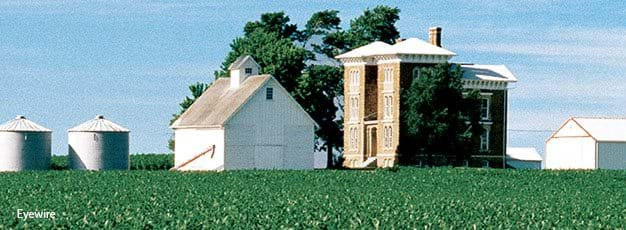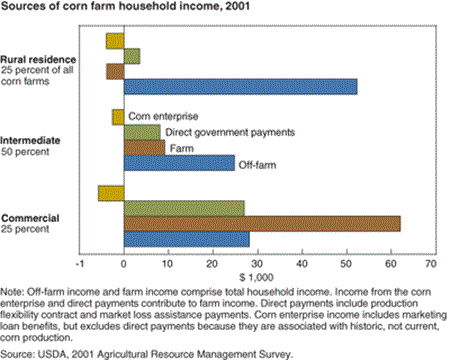Farm Income Less Important to Most Corn Farm Households

U.S. farm policy supports farm household income in part by aligning government payments with (current and historic) production of commodities like corn, wheat, rice, or cotton. When commodity programs were conceived in the 1930s, government support was a key component of farm income. As economic conditions changed over time, however, commodity production has played a lesser role in farm household income and well-being, while off-farm income has become more important, a trend that has been documented in several ERS studies. One example is a recent analysis of data on corn farms from USDA's 2001 Agricultural Resource Management Survey. It shows that the relative importance of the different components of farm household income varies by farm type, but that off-farm income is most important for a majority of farm households.
Rural residence farms (about 25 percent of farm households) had little farm-related income and averaged a negative return from both the farm and corn enterprise in 2001. Off-farm sources generated nearly all of the household income (more than $50,000 per farm) on these farms where operators, by definition, work primarily off-farm or are retired.
Farm policy is more germane to farm household income on intermediate (less than $250,000 in annual farm sales) and commercial ($250,000 or more) farms, where farming is the primary occupation. On intermediate farms (about 50 percent of corn farm households), direct government payments averaged about $8,000 per farm, accounting for nearly 90 percent of farm-related income. Still, more than 70 percent of total household income on intermediate farms was generated from off-farm sources.
By contrast, farming generated nearly 70 percent of total household income on commercial corn farms (about 25 percent of corn farms). More than $60,000 of household income (about $90,000 on average) was from farm-related sources on commercial farms in 2001, with about 40 percent of farm-related income from direct government payments. The corn enterprise resulted in a loss, on average, of about $6,000 per farm.
Low crop prices for corn and other crops grown on corn farms, along with high costs for fuels and fertilizers, reduced commodity returns in 2001. Government payments offset lower commodity returns to some extent, and supported farm income on most farms. However, the large discrepancy between farm and off-farm income on three-fourths of corn farms suggests a loose connection between farm commodity returns and household income for most corn farm households. This pattern is likely to persist even when commodity returns are higher, as they were in 2003 and 2004. The well-being of most farm households now depends on economic conditions and opportunities off the farm much more than on factors affecting the return to farming.
ARMS Farm Financial and Crop Production Practices, by ARMS Team, USDA, Economic Research Service, December 2023
Commodity Costs and Returns, by Jeffrey Gillespie, USDA, Economic Research Service, November 2023


